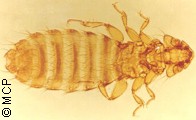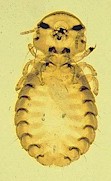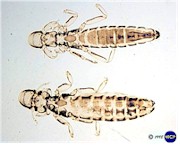All lice species that affect poultry and most domestic birds belong to the group of Mallophaga or bird lice. There are more than 40 species worldwide. Most of them are cosmopolitan, i.e., they occur almost everywhere. In most cases infested birds carry lice of several species simultaneously.
Many species infest poultry as well as other domestic birds such as turkeys, pigeons, guinea fowls, ducks, geese, etc., and wild birds too, i.e., they can re-infest each other if they come in contact.
Lice infestations are usually called pediculosis.
Biology and life cycle of poultry lice

Adult lice are rather small insects (1.5 to 3.5 mm) and wingless. They are found mainly in and around the feathers, especially at their base, and on the body surface. They have strong chewing mouthparts and feed on feather and skin debris as well as on body exudates. Some species may even feed on blood that comes out of the wounds they produce.
Lice are obligate parasites that spend their whole life on the hosts: they do not survive off the birds longer than a few days. They are hemimetabolic, i.e. they undergo an incomplete metamorphosis.
Adult females lay eggs (nits) at the base of the feathers' shafts. Each female lays up to a few hundred eggs during her lifetime, depending on the species. Eggs are visible for the naked eye as whitish masses, frequently at the base of the feathers. Larvae hatch 4 to 7 days after egg deposition and develop progressively to nymphs and adults. The lifecycle takes 3 to 5 weeks to complete, depending on the species. Lice live for various months, but off the host they won't survive more than a week.
Since temperature and humidity remain quite constant on the body surface of the birds, lice populations are not very susceptible to seasonal changes in climatic and ecological conditions, especially indoors.
Transmission of lice is by contact between birds, typically from hens to chicks. Therefore spreading of lice within a bird flock is mainly driven by crowding that favors close contacts.
Click here to learn more about the general biology of insects.
Main species of lice on domestic birds

Cuclotogaster heterographa, the head louse, is about 2.5 mm long and is found mainly on the head and the neck of birds. It prefers to stay close to the skin or at the base of the feathers. It does not suck blood, but feeds on skin and feather debris. It is more frequent on young birds and turkeys. Heavy infested birds may even die before maturity.
Eomenacanthus stramineus (= Menacanthus stramineus), the chicken body louse is the most common species on domestic birds, and probably the most damaging one. It is rather large (2.5 to 3.5 mm long) and of a brownish color. It feeds mainly on feather debris, but is capable of sucking blood. It lives mostly on the skin of birds, seldom on the feathers, and prefers body parts with few feathers, e.g. around the vent, although in case of heavy infestations it may be found also on the head, under the wings and on the chest. The eggs are laid in clusters on the feathers or directly on the kin.
Goniocotes gallinae, the fluff louse, is one of the smallest lice of poultry, only 0.8 to 1.5 mm long. It is found all over the birds' body, but less densely on the head and the wings, on the fluff or base of the feathers. It also feeds mainly on feather debris.
Lipeurus caponis, the wing louse, is 2.0 to 2.5 mm long, and has a grayish color. It is found mainly in the inner part of wing, tail and head feathers. It only feeds on parts of the feathers, but so intensively, that is also called the depluming louse.
Menopon gallinae, the shaft louse, is rather small (1.5 to 2.0 mm long). It feeds mainly on skin and feather debris, but may also suck blood from the wounds it produces. It prefers the chest, the shoulders and the back of birds. Eggs are whitish and are laid often in clusters at the base of the feathers.
Columbicola columbae, the slender pigeon louse, is 2.0 to 2.8 mm long. It can be found all over the body, especially at the inner side of the wing feathers. It feeds on feather debris. Eggs are laid preferentially are the small feathers under the wings.
Damage, harm and economic importance

Infestations with a few lice are usually harmless for the birds. But massive infestations can substantially reduce performance and reproduction. Lice bites are irritating: affected birds become restless, won't feed and sleep well, and peck or scratch themselves intensively. They may even injure themselves. Weight gain and laying performance may be reduced for up to 45% in case of heavy infestations.
Lice are usually a problem only on poultry kept under traditional conditions, especially on layers. They are usually not a problem in modern industrial poultry operations, although outbreaks can happen in layers and even in breeding operations kept under poor conditions. The broiler cycle is mostly too short to allow the build up of large lice populations.
Prevention and control of lice on poultry
The first priority to avoid outbreaks of lice on poultry houses is to prevent the introduction of lice from outside, since wild birds can transmit most lice species. The second measure is to prevent dissemination of lice between poultry houses, if one of them becomes infested.
Nests of wild birds in or around the facilities have to be destroyed. Whatever equipment or hardware is moved between poultry houses (cages, baskets, crates, boxes, trays, etc.) it has to be disinfected before being introduced into a louse-free building.
Good control of infestations without using synthetic lousicides has been achieved with thuringiensin, the exotoxine of Bacillus thuringiensis, directly applied on infested birds. However, commercial products with thuringiensin may not be available everywhere for use on poultry, although they are quite common in agriculture.
Lice remain always on the birds. Consequently, chemical control with whatever lousicides has to be directly administered to the birds and not to the facilities or the environment of the birds. Most common lousicide application is by spraying (hand or power spray) the birds directly. Dipping is less frequent but will work as well. Dusting also works and it allows treating the birds indirectly, e.g. applying the insecticidal powder to the bedding and letting the birds dust themselves. However, roosters don't dust themselves like hens and it may be necessary to treat them separately. Laying hens have to be treated directly.
Most synthetic lousicides belong to the organophosphates, carbamates, and pyrethroids and are usually available as concentrates to be diluted before use. Care must be taken particularly with some organophosphates that may be toxic to birds if slightly overdosed.
Macrocyclic lactones (e.g. ivermectin) either as feed additives or as tablets are available for poultry in a few countries, mainly for fighting roosters. However, at the therapeutic dose they are unlikely to control poutry lice. In most countries they are not aproved for poultry at all: neither for layers nor for broilers, due to excessive residues in eggs and/or meat.
For the time being there are no vaccines that will protect poultry by making them immune to lice. There are no repellents, natural or synthetic that will keep lice away from poultry. And there are no traps for catching poultry lice, for the simple reason that they spend their whole life on the animals and therefore there are no stages in the environment searching or waiting for a host.
So far there are no effective biological control methods against poultry lice. Learn more about biological control of insects.
Click here if you are interested in medicinal plants for controlling lice and other external parasites of poultry, other livestock and pets.
There is also additional information in this site on the general features of parasiticides and ectoparasiticides, as well as on parasiticidal chemical classes and active ingredients.
| If available, follow more specific national or regional recommendations or regulations for poultry lice control. |
Insecticide resistance of poultry lice
So far there are no reports on resistance of poultry lice to lousicides.
This means that if a particular product has not achieved the expected control, it is most likely because the product is not adequate or it was not used correctly, not because lice have become resistant.
Learn more about parasite resistance and how it develops.